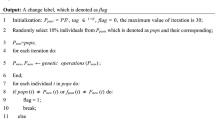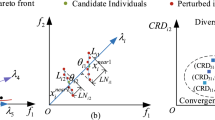Abstract
Dynamic Multiobjective Problems cover a set of real-world problems that have many conflicting objectives. These problems are challenging and well known by the dynamic nature of their objective functions, constraint functions, and problem parameters which often change over time. In fact, dealing with these problems has not been investigated in detail using the Estimation of Distribution Algorithms (EDAs). Thus, we propose in this paper an EDA-based on Vine Copulas algorithm to deal with Dynamic Multiobjective Problems (DMOPs). Vines Copulas are graphical models that represent multivariate dependence using bivariate copulas. The proposed Copula-based Estimation of Distribution Algorithm, labeled Dynamic Vine-Copula Estimation of Distribution Algorithm (DynVC-EDA), is used to implement two search strategies. The first strategy is an algorithm that uses the model as a memory to save the status of the best solutions obtained during the current generation. The second strategy is a prediction-based algorithm that uses the history of the best solutions to predict a new population when a change occurs. The proposed algorithms are tested using a set of benchmarks provided with CEC2015 and the Gee-Tan-Abbass. Statistical findings show that the DynVC-EDA is competitive to the state-of-the-art methods in dealing with dynamic multiobjective optimization.














Similar content being viewed by others
References
Aas K, Czado C, Frigessi A, Bakken H (2009) Pair-copula constructions of multiple dependence. Insur Math Econ 44(2):182–198
Abualigah LM, Khader AT (2017) Unsupervised text feature selection technique based on hybrid particle swarm optimization algorithm with genetic operators for the text clustering. J Supercomput 73(11):4773–4795. https://doi.org/10.1007/s11227-017-2046-2
Abualigah LMQ (2019) Feature selection and enhanced krill herd algorithm for text document clustering. Springer, Berlin
Abualigah LMQ, Hanandeh ES (2015) Applying genetic algorithms to information retrieval using vector space model. Int J Comput Sci Eng Appl 5(1):19
Al-Sahaf H, Bi Y, Chen Q, Lensen A, Mei Y, Sun Y, Tran B, Xue B, Zhang M (2019) A survey on evolutionary machine learning. J R Soc N Zeal 49(2):205–228. https://doi.org/10.1080/03036758.2019.1609052
Azzouz R, Bechikh S, Ben Said L (2017) Dynamic multi-objective optimization using evolutionary algorithms: a survey. Springer, Cham, pp 31–70
Azzouz R, Bechikh S, Said LB (2017) A dynamic multi-objective evolutionary algorithm using a change severity-based adaptive population management strategy. Soft Comput 21(4):885–906
Bedford T, Cooke RM (2002) Vines-a new graphical model for dependent random variables. Ann Stat 30(4):1031–1068. https://doi.org/10.1214/aos/1031689016
Cheriet A, Cherif F (2015) A posteriori Pareto front diversification using a copula-based estimation of distribution algorithm. Int J Adv Comput Sci Appl (IJACSA) 6:13
Cheriet A, Cherif F, Taleb-Ahmed A (2016) Fast solutions enhancing using a copula-based EDA and SVM for many-objective problems. IFAC-PapersOnLine 49(12):781–786
Cheriet A, Santana R (2018) Modeling dependencies between decision variables and objectives with copula models. In: Proceedings of the genetic and evolutionary computation conference companion, GECCO ’18. ACM, New York, NY, USA, pp 175–176. https://doi.org/10.1145/3205651.3205694
Cheriet A, Santana R (2019) Optimizing permutation-based problems with a discrete vine-copula as a model for eda. In: Proceedings of the genetic and evolutionary computation conference companion. ACM, pp 143–144
Cherubini U, Luciano E, Vecchiato W (2004) Copula methods in finance. Wiley, New York
Coello CAC, Van Veldhuizen DA, Lamont GB (2002) Evolutionary algorithms for solving multi-objective problems, vol 242. Springer, Berlin
Cuesta-Infante A, Santana R, Hidalgo JI, Bielza C, Larrañaga P (2010) Bivariate empirical and n-variate Archimedean copulas in estimation of distribution algorithms. In: Proceedings of the 2010 congress on evolutionary computation CEC-2010. IEEE, Barcelone, Spain, pp 1–8. https://doi.org/10.1109/CEC.2010.5586557
Czado C (2010) Pair-copula constructions of multivariate copulas. Copula theory and its applications. Springer, Berlin, pp 93–109
Deb K, Karthik S et al (2007) Dynamic multi-objective optimization and decision-making using modified NSGA-II: a case study on hydro-thermal power scheduling. In: Evolutionary multi-criterion optimization. Springer, pp 803–817
Deb K, Pratap A, Agarwal S, Meyarivan T (2002) A fast and elitist multiobjective genetic algorithm: NSGA-II. IEEE Trans Evol Comput 6(2):182–197
Devroye L (1986) Sample-based non-uniform random variate generation. In: Proceedings of the 18th conference on winter simulation, WSC ’86. ACM, New York, NY, USA, pp 260–265. https://doi.org/10.1145/318242.318443
Etxeberria R, Larranaga P (1999) Global optimization using Bayesian networks. In: Second symposium on artificial intelligence (CIMAF-99). Habana, Cuba, pp 332–339
Farina M, Deb K, Amato P (2004) Dynamic multiobjective optimization problems: test cases, approximations, and applications. IEEE Trans Evol Comput 8(5):425–442
Gao Y (2009) Multivariate estimation of distribution algorithm with Laplace transform Archimedean copula. In: International conference on information engineering and computer science, 2009. ICIECS 2009. IEEE, pp 1–5
Gao Y, Hu X, Liu H (2010) Estimation of distribution algorithm based on multivariate Gaussian copulas. In: 2010 IEEE International conference on progress in informatics and computing (PIC), vol 1. IEEE, pp 254–257
Gee SB, Tan KC, Abbass HA (2017) A benchmark test suite for dynamic evolutionary multiobjective optimization. IEEE Trans Cybern 47(2):461–472. https://doi.org/10.1109/TCYB.2016.2519450
Genest C, Rémillard B, Beaudoin D (2009) Goodness-of-fit tests for copulas: a review and a power study. Insur Math Econ 44(2):199–213
Genest C, Rivest LP (1993) Statistical inference procedures for bivariate archimedean copulas. J Am Stat Assoc 88(423):1034–1043. https://doi.org/10.1080/01621459.1993.10476372
Goh CK, Tan KC (2008) A competitive-cooperative coevolutionary paradigm for dynamic multiobjective optimization. IEEE Trans Evol Comput 13(1):103–127
González-Fernández Y, Soto M (2012) A survey of estimation of distribution algorithms based on copulas. Technical Report, 2012, technical Report ICIMAF p 679
Hauschild M, Pelikan M (2011) An introduction and survey of estimation of distribution algorithms. Swarm Evol Comput 1(3):111–128
Helbig M, Engelbrecht A (2015) Benchmark functions for cec, special session and competition on dynamic multi-objective optimization. Technical report
Helbig M, Engelbrecht AP (2013) Benchmarks for dynamic multi-objective optimisation. In: 2013 IEEE symposium on computational intelligence in dynamic and uncertain environments (CIDUE). IEEE, pp 84–91
Helbig M, Engelbrecht AP (2013) Issues with performance measures for dynamic multi-objective optimisation. In: 2013 IEEE symposium on computational intelligence in dynamic and uncertain environments (CIDUE). IEEE, pp 17–24
Helbig M, Engelbrecht AP (2013) Performance measures for dynamic multi-objective optimisation algorithms. Inf Sci 250:61–81
Hyrš M, Schwarz J (2014) Multivariate Gaussian copula in estimation of distribution algorithm with model migration. In: 2014 IEEE symposium on foundations of computational intelligence (FOCI). IEEE, pp 114–119
Joe H (2014) Dependence modeling with copulas. CRC Press, Boca Raton
Kim G, Silvapulle MJ, Silvapulle P (2007) Comparison of semiparametric and parametric methods for estimating copulas. Comput Stat Data Anal 51(6):2836–2850
Larranaga P, Lozano JA (2002) Estimation of distribution algorithms: a new tool for evolutionary computation, vol 2. Springer, Berlin
Martins MS, Delgado M, Lüders R, Santana R, GonçSalves RA, de Almeida CP (2018) Exploring the probabilistic graphic model of a hybrid multi-objective Bayesian estimation of distribution algorithm. Appl Soft Comput 73:328–343
Martins MSR, Yafrani ME, Santana R, Delgado M, Lüders R, Ahiod B (2018) On the performance of multi-objective estimation of distribution algorithms for combinatorial problems. In: 2018 IEEE congress on evolutionary computation (CEC), pp 1–8. https://doi.org/10.1109/CEC.2018.8477970
Muruganantham A, Tan KC, Vadakkepat P (2016) Solving the IEEE CEC 2015 dynamic benchmark problems using Kalman filter based dynamic multiobjective evolutionary algorithm. In: Lavangnananda K, Phon-Amnuaisuk S, Engchuan W, Chan JH (eds) Intelligent and evolutionary systems. Springer, Cham, pp 239–252
Nelsen RB (2013) An introduction to copulas, vol 139. Springer, Berlin
Nguyen TT, Yang S, Branke J (2012) Evolutionary dynamic optimization: a survey of the state of the art. Swarm Evol Comput 6:1–24
Pelikan M, Sastry K, Goldberg DE (2006) Multiobjective estimation of distribution algorithms. In: Pelikan M, Sastry K, Cantú-Pa E (eds) Scalable optimization via probabilistic modeling. Springer, Berlin, pp 223–248
Salinas-Gutiérrez R, Hernández-Aguirre A, Villa-Diharce ER (2009) Using copulas in estimation of distribution algorithms. In: MICAI 2009: advances in artificial intelligence. Springer, pp 658–668
Salinas-Gutiérrez R, Hernández-Aguirre A, Villa-Diharce ER (2010) D-vine EDA: a new estimation of distribution algorithm based on regular vines. In: Proceedings of the 12th annual conference on genetic and evolutionary computation. ACM, pp 359–366
Salinas-Gutiérrez R, Hernández-Aguirre A, Villa-Diharce ER (2013) Incorporating regular vines in estimation of distribution algorithms. In: EVOLVE-A Bridge between Probability, set oriented numerics and evolutionary computation. Springer, pp 91–121
Sastry K, Goldberg DE, Pelikan M (2005) Limits of scalability of multiobjective estimation of distribution algorithms. In: The 2005 IEEE congress on evolutionary computation, 2005, vol 3. IEEE, pp 2217–2224
Shakya S, McCall J (2007) Optimization by estimation of distribution with deum framework based on markov random fields. Int J Autom Comput 4(3):262–272
Sheather SJ, Jones MC (1991) A reliable data-based bandwidth selection method for kernel density estimation. J R Stat Soc Ser B (Methodol) 53:683–690
Sklar A (1973) Random variables, distribution functions, and copulas. Kybernetica 28:449–460
Slowik A, Kwasnicka H (2020) Evolutionary algorithms and their applications to engineering problems. Neural Comput Appl 32(16):12363–12379. https://doi.org/10.1007/s00521-020-04832-8
Soto M, Gonzalez-Fernandez Y (2010) Vine estimation of distribution algorithm. Technical report. 2010-561, ICIMAF
Soto M, Gonzalez-Fernandez Y, Ochoa A (2012) Modeling with copulas and vines in estimation of distribution algorithms. arXiv preprint arXiv:1210.5500
Soto M, Ochoa A, Arderí RJ (2007) Gaussian copula estimation of distribution algorithm. Technical report. 2007-406, ICIMAF
Soto MR, Ochoa A, González-Fernández Y, Milanés Y, Álvarez A, Carrera D, Moreno E (2012) Vine estimation of distribution algorithms with application to molecular docking. In: Shakya S, Santana R (eds) Markov networks in evolutionary computation. Springer, Berlin, pp 175–190
Tsukahara H (2005) Semiparametric estimation in copula models. Can J Stat 33(3):357–375
Wang L, Guo X, Zeng J, Hong Y (2010) Using Gumbel copula and empirical marginal distribution in estimation of distribution algorithm. In: 2010 Third international workshop on advanced computational intelligence (IWACI). IEEE, pp 583–587
Wang LF, Zeng JC (2010) Estimation of distribution algorithm based on copula theory. In: Chen Y (ed) Exploitation of linkage learning in evolutionary algorithms. Springer, Berlin, pp 139–162
Wang LF, Zeng JC, Hong Y (2009) Estimation of distribution algorithm based on archimedean copulas. In: Proceedings of the first ACM/SIGEVO summit on genetic and evolutionary computation, GEC ’09. Association for Computing Machinery, New York, NY, USA, pp 993–996. https://doi.org/10.1145/1543834.1543991
Wang Y, Li B (2010) Multi-strategy ensemble evolutionary algorithm for dynamic multi-objective optimization. Memet Comput 2(1):3–24
Yan J et al (2007) Enjoy the joy of copulas: with a package copula. J Stat Softw 21(i04):1–21
Zhang Q, Li H (2007) MOEA/D: a multiobjective evolutionary algorithm based on decomposition. IEEE Trans Evol Comput 11(6):712–731
Zhang Q, Liu W, Li H (2009) The performance of a new version of moea/d on CEC09 unconstrained mop test instances. IEEE Cong Evol Compt 1:203–208
Zhang Q, Yang S, Jiang S, Wang R, Li X (2019) Novel prediction strategies for dynamic multiobjective optimization. IEEE Trans Evol Comput 24(2):260–274
Zhang Q, Zhou A, Jin Y (2008) RM-MEDA: a regularity model-based multiobjective estimation of distribution algorithm. IEEE Trans Evol Comput 12(1):41–63
Zhou A, Jin Y, Zhang Q (2014) A population prediction strategy for evolutionary dynamic multiobjective optimization. IEEE Trans Cybern 44(1):40–53
Zhou A, Qu BY, Li H, Zhao SZ, Suganthan PN, Zhang Q (2011) Multiobjective evolutionary algorithms: a survey of the state of the art. Swarm Evol Comput 1(1):32–49
Zitzler E, Laumanns M, Thiele L, Zitzler E, Zitzler E, Thiele L, Thiele L (2001) SPEA2: improving the strength pareto evolutionary algorithm
Zou F, Yen GG, Tang L, Wang C (2021) A reinforcement learning approach for dynamic multi-objective optimization. Inf Sci 546:815–834. https://doi.org/10.1016/j.ins.2020.08.101
Acknowledgements
I want to express my very great appreciation to Professor Roberto Santana for his valuable and constructive suggestions during the planning and development of this research paper. His willingness to give his time so generously has been very much appreciated.
Author information
Authors and Affiliations
Corresponding author
Additional information
Publisher's Note
Springer Nature remains neutral with regard to jurisdictional claims in published maps and institutional affiliations.
Rights and permissions
About this article
Cite this article
Cheriet, A. Vine copula-based EDA for dynamic multiobjective optimization. Evol. Intel. 15, 455–479 (2022). https://doi.org/10.1007/s12065-020-00523-4
Received:
Revised:
Accepted:
Published:
Issue Date:
DOI: https://doi.org/10.1007/s12065-020-00523-4




